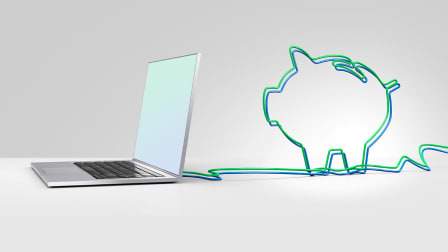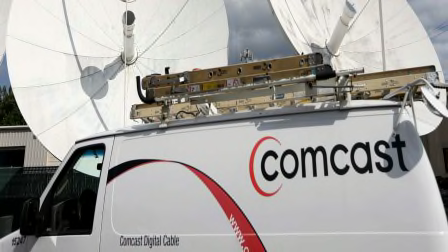You May Be Paying Too Much for Your Internet
Consumer Reports' analysis of thousands of bills showed costs vary widely—and charges can be higher when people have fewer providers to choose from. But there are ways to save.

Like many of her neighbors in East Carroll parish, in rural northeast Louisiana, Wanda Manning has struggled to get decent, affordable internet service. “I’m paying a lot of money each month, about $140, to get internet and phone service, but the internet isn’t dependable,” she says. “I often have problems staying connected. I’ll be in a meeting one minute, and the next minute I’ll find I’m no longer online.”
But Manning, a retired teacher who is part of a local church organization that has made headlines fighting to bring better internet service to East Carroll, is better off than many others in the community, who either don’t have internet or have to rely on dial-up service. “When I was teaching school remotely, we had people walking around their trailers holding up MyFi mobile hotspots just so their kids could be in school,” she says.
East Carroll is not unusual. In communities across the country, millions of people find it hard to find or afford a reliable high-speed internet connection. In addition, many internet bills are confusing, making it difficult and sometimes impossible for consumers to compare prices when shopping for a better, less expensive plan.
Those problems emerged from an analysis of more than 22,000 internet bills that Consumer Reports and several partner organizations collected from people around the country. Data from the project will be used to support a public-service and advocacy campaign called “Fight for a Fair Internet,” to encourage lawmakers, regulators, and internet service providers (ISPs) to improve broadband access and affordability.
The needs have been sharpened by COVID-19. Even as the pandemic eases, many people still work from home and use the internet to access healthcare. And it’s hard for kids to succeed in school without a fast, stable broadband connection in their home.
The investigation also provided further indications of a problem consumer advocates have highlighted for years: Many households lack much meaningful choice when it comes to internet service providers. Studies have found that internet prices are generally lower in communities where two or more ISPs offer internet service.
Internet Bills Are Often Confusing
Research on broadband access and pricing typically relies on industry-reported data. To generate an independent overview, the CR investigation collected bills from consumers in all 50 states, the District of Columbia, Puerto Rico, and the U.S. Virgin Islands, and from close to 700 separate ISPs. The volunteers who contributed their bills had various types of internet service, including coaxial cable, fiber optic, satellite, fixed wireless, and DSL.
Many participants also took internet speed tests, and completed a survey designed to capture demographic data and to gauge their satisfaction with and the reliability of their internet service. Researchers did not extract personally identifiable information from the bills; only ZIP codes were retained to let researchers look for regional differences in billing and service.
CR then spent more than 10 months extracting and analyzing data from the bills. While this is not a nationally representative study and is not predictive of the broadband market, it is one of the most ambitious efforts of its kind to understand how much consumers are paying at a moment in time.
It quickly became clear how hard it must be for many consumers to decipher their own bills.
Comcast/Xfinity, the nation’s biggest ISP, is among several companies that don’t list the price for internet separately when that service is bundled together with cable TV and phone service. Fees proved even particularly confounding. It was often hard to determine whether they were associated with broadband or with one of those other services. (If researchers couldn’t determine whether an item on a bill was tied specifically to internet service, they didn’t count it.)


Bills that included discounts were confusing, too. Everyone likes to get a deal, but many bills make it difficult for consumers—or researchers—to determine the actual price of internet service. It’s often unclear when a promotional discount might end, and what the price would be afterward.
“Some of the bills we collected are incredibly complicated,” says Jonathan Schwantes, senior policy counsel at CR, who helped lead the analysis. “In thousands of cases, it is too hard for people to figure out what they’re paying for, what the hidden fees mean, or to even locate the price for internet service.”
Alan Patten, a retired IT worker who lives about 30 miles outside of Atlanta, had seen his monthly bill for internet and cable TV balloon from about $150 to nearly $200 a month, and wanted to know how much he’d still have to pay if he dropped cable. “It was extremely difficult. I went through my bill a number of times trying to decipher all the charges, especially with all the add-on fees,” he says. “I couldn’t tell which fees applied to each of the services. The only way I was finally able to find out how much internet alone would cost was to call the company and actually cancel the TV part.”
The NCTA-Internet & Television Association, a trade group, disputes such complaints. “Cable providers continue to provide consumers with transparent billing information on their websites and promotional materials,” says Brian Dietz, senior vice president, strategic communications for the organization.
Pricing Varies Widely
Nearly one-third of Americans who don’t have broadband say it’s because “it costs too much,” according to a nationally representative CR survey (PDF) of 2,076 U.S. adults conducted in May 2022. Around 3 in 10 people who do have service say they find it “somewhat” or “very” difficult to afford.
Among the bills CR’s researchers analyzed, the pre-discount price for internet service ranged from less than $10 all the way to $200 a month, with about half of people paying $60 to $90 a month. The advertised speeds across the entire study varied dramatically, with most ranging from 25 megabits per second (Mbps) up to 1 gigabit per second (Gbps), or roughly 40 times faster.
Those prices include fees for service enhancements such as “speed boosts.” And many participants in the study pay fees for equipment (router or modem rentals, for example), installation, and activation. Other fees are difficult to understand. For instance, Optimum bills analyzed by the researchers include a “network enhancement fee.”
Such fees aren’t usually included in the advertised price of an internet service plan. Unless a consumer pores through a lot of fine print before signing up, it’s easy to get surprised when monthly bills start arriving. (Consumer Reports has found similar problems with the cable portion of consumers’ monthly bills.)
Internet service pricing can appear unpredictable in another respect, too. CR’s researchers found a number of instances where ISPs charge widely different prices for the same service plans, though not necessarily in the same communities.
Average cost
with discounts: $
without discounts: $
Average monthly cost of equipment: $
However, there is one way in which pricing is fairly consistent across the country: In neighborhoods where there’s competition, prices are generally lower, sometimes significantly so.
“Our findings suggest that consumers pay less for broadband in areas where multiple providers compete for their business—and, not surprisingly, tend to be more satisfied with their internet service provider,” CR’s Schwantes says.
Internet prices were lower, on average, in ZIP codes where CR received bills for multiple companies. The data has some limitations: Researchers didn’t independently determine how many ISPs operate in each area. However, previous studies have reached the same conclusion.
BroadbandNow, a research and data aggregation firm, says that the average price for broadband is about 15 percent lower for those living in an area with at least three providers compared with those with only one. And it’s 40 percent lower in the cities with the most competition.
“In areas of the U.S. with less choice among internet service providers, consumers are faced with higher prices and lower levels of service,” says John Busby, managing director of BroadbandNow, which has been studying internet access, coverage, and pricing since 2016. “This is most felt in rural areas where costs are significantly higher than equivalent service for city dwellers that have multiple choices.”
Along with pricing, BroadbandNow says consumers can often get faster broadband in areas where they have multiple providers to choose from. “Speeds tend to trend upward as more competition is added to the market—likely a natural function of the increased competitiveness in those areas,” Busby says.
Many Americans lack that level of choice. In a survey of 33,204 CR members conducted earlier this year to inform our ISP ratings, 22 percent of respondents said they had only one provider available, while another 30 percent said they had just two.
The NCTA cites far higher numbers. “Ninety-seven percent of Americans have at least four choices for wired or wireless broadband service, according to the [Federal Communications Commission],” says the organization’s Dietz.
Such figures come from FCC data generated with a “deeply flawed” methodology, according to CR’s Schwantes, one that is currently being revised. Additionally, the figures include technologies deemed slow and unreliable by many consumers, including satellite internet service—which covers essentially the whole country. (Satellite ISPs have appeared at the very bottom of CR’s ratings with low ratings for reliability, speed, and value.)
“When looking at consumers’ real choices for broadband as they exist today, it’s the wired connection to the home that matters most,” Schwantes says. “According to the FCC’s counts for wired broadband like cable or fiber to the home, only 11 percent of consumers have three or more choices for broadband service.”
What You Can Do
Despite the difficulties many consumers face, there are reasons for optimism. The confusion over pricing could ease starting in 2023, when ISPs will be required to start producing standardized broadband “nutrition labels” that consumers can access when they are shopping for an internet plan. CR has long supported the labels, which are mandated by the 2021 infrastructure law—and strongly advocates having the labels mandated for monthly bills, as well.
In addition, there are steps you can take to make sure you’re getting the best deal possible, and that you have reliable service. Follow these tips, and consult our complete guide to saving money on internet.
Check to make sure you’re getting the speed that’s advertised. You can do that at Speedtest by Ookla or M-Labs, ideally using a wired Ethernet connection to your computer. Most ISPs stop short of guaranteeing a certain speed, often by promising only to deliver “up to” that rate. But if you’re consistently getting much slower speeds, it’s worth contacting the company to see whether it can do something to improve your service, or at least help you troubleshoot the problem.
Make sure your WiFi is working well. If you find that the speeds seem slower on devices connected via WiFi, the problem could be with an older router, or its location. First redo the speed test connecting via WiFi. If it’s slower, try moving the router to a more central location in your home. You can try a WiFi extender to reach a more distant room in the house, or consider getting a mesh router system, which uses multiple units to provide whole-house coverage.
Negotiate with your internet provider. In survey after survey, CR members have confirmed that it pays to haggle with your ISP for either a lower price or better service, such as faster speeds. Besides, there’s no downside to trying.
Avoid installation charges. Many ISPs offer free or low-cost self-installation kits that include everything you need to set up your WiFi. Once it arrives, just follow the instructions to plug everything in and get your WiFi working. Some companies have apps that offer step-by-step guidelines.
Buy, rather than rent, your router. You can avoid this recurring monthly fee, and it will typically pay off within the first one to two years of ownership.
Take advantage of any ISP discounts and auto-pay programs. There are also new subsidies that can help with affordability. For example, under the new Affordable Connectivity Program households that meet eligibility requirements can get a discount of up to $30 per month on internet service, or $75 per month for those living on tribal lands. You can find out more on the Federal Communications Commission’s ACP website.
Editor’s Note: This project was made possible in part through the generous support of Consumer Reports donor Cherri Pancake.




















